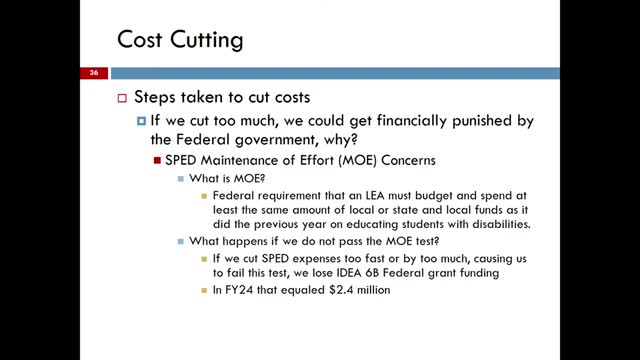School budget cuts threaten $2.4 billion in federal funding
August 07, 2024 | Catoosa County, School Districts, Georgia

This article was created by AI summarizing key points discussed. AI makes mistakes, so for full details and context, please refer to the video of the full meeting. Please report any errors so we can fix them. Report an error »

During a recent government meeting, officials discussed critical budgetary requirements and strategies for managing educational funding, particularly for students with disabilities. A key focus was the federal mandate that school systems must maintain their spending levels on special education. Failure to meet this \"maintenance of effort\" could result in the loss of approximately $2.4 billion in federal funding, which would significantly impact staffing for special education programs.
To address rising costs, the school system has implemented several cost-cutting measures, including increasing insurance deductibles and adjusting policy limits, which have already yielded savings of about $65,000. Additionally, an expanded shared savings program has generated an extra $150,000 in savings over the past year. A new accounting standard from the Government Accounting Standards Board (GaSB 96) allows the use of Education Special Purpose Local Option Sales Tax (ESPLOS) funds for certain instructional tools and subscriptions, providing further financial flexibility.
The projected budget for the upcoming year is based on an enrollment of 9,941 students and includes funding for 150 teachers and 170 paraprofessionals. The budget anticipates revenue from various sources, including property taxes, which are projected to total over $45 million, alongside other local and state funding amounting to nearly $85 million.
Despite these efforts, officials noted that personnel costs cannot be covered by ESPLOS funds, highlighting ongoing challenges in managing educational expenses while ensuring compliance with federal requirements. The meeting underscored the importance of strategic financial planning to sustain educational services amid fiscal constraints.
To address rising costs, the school system has implemented several cost-cutting measures, including increasing insurance deductibles and adjusting policy limits, which have already yielded savings of about $65,000. Additionally, an expanded shared savings program has generated an extra $150,000 in savings over the past year. A new accounting standard from the Government Accounting Standards Board (GaSB 96) allows the use of Education Special Purpose Local Option Sales Tax (ESPLOS) funds for certain instructional tools and subscriptions, providing further financial flexibility.
The projected budget for the upcoming year is based on an enrollment of 9,941 students and includes funding for 150 teachers and 170 paraprofessionals. The budget anticipates revenue from various sources, including property taxes, which are projected to total over $45 million, alongside other local and state funding amounting to nearly $85 million.
Despite these efforts, officials noted that personnel costs cannot be covered by ESPLOS funds, highlighting ongoing challenges in managing educational expenses while ensuring compliance with federal requirements. The meeting underscored the importance of strategic financial planning to sustain educational services amid fiscal constraints.
View full meeting
This article is based on a recent meeting—watch the full video and explore the complete transcript for deeper insights into the discussion.
View full meeting
